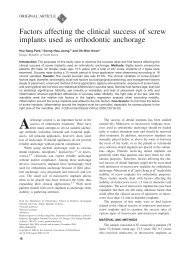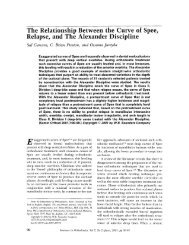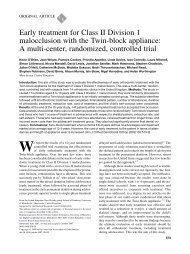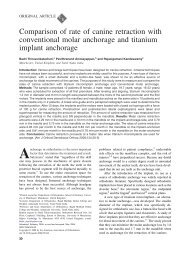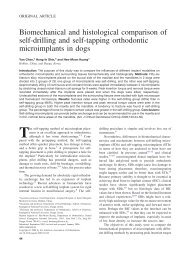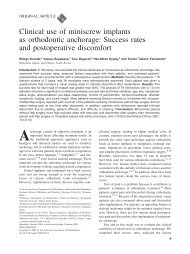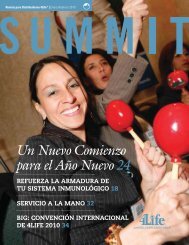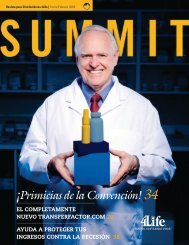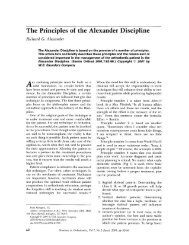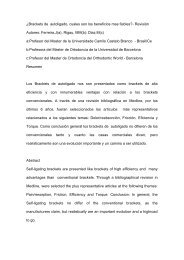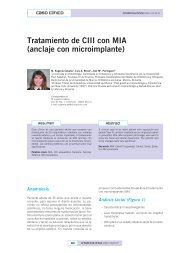Leveling the curve of Spee with a continuous archwire technique: A ...
Leveling the curve of Spee with a continuous archwire technique: A ...
Leveling the curve of Spee with a continuous archwire technique: A ...
You also want an ePaper? Increase the reach of your titles
YUMPU automatically turns print PDFs into web optimized ePapers that Google loves.
370 Bernstein, Preston, and Lampasso<br />
second-order movement relapsed an average <strong>of</strong> 1.87°<br />
(SD, 4.63°), resulting in a mean long-term uprighting<br />
<strong>of</strong> –4.55°.<br />
A straight-wire approach to Class II orthodontic<br />
treatment requiring leveling <strong>of</strong> <strong>the</strong> COS has been<br />
associated <strong>with</strong> increases in <strong>the</strong> vertical dimensions <strong>of</strong><br />
<strong>the</strong> face. 3,5-7 An analysis <strong>of</strong> <strong>the</strong> data from this study<br />
shows that in our patients <strong>the</strong> treatment did not have a<br />
major effect on 2 measurements <strong>of</strong> lower facial height.<br />
Although <strong>the</strong> Y-axis changed statistically significantly<br />
from T1 to T2 (P .001), <strong>the</strong> mean change was only <br />
1.05°. During treatment, <strong>the</strong> MP angle (SN-MP)<br />
changed by less than a mean <strong>of</strong> 1.0° (SD, 2.43°),<br />
which was not statistically significant (P .0316).<br />
There were changes in <strong>the</strong> mean angular relationships<br />
<strong>of</strong> <strong>the</strong> OP during treatment. During treatment,<br />
<strong>the</strong>re were a mean reduction <strong>of</strong> –2.98° in <strong>the</strong> SN-OP<br />
angle and a mean increase <strong>of</strong> 3.90° in <strong>the</strong> OP-MP angle.<br />
These changes occurred during <strong>the</strong> leveling <strong>of</strong> <strong>the</strong> COS,<br />
and <strong>the</strong>y represent counterclockwise rotation in <strong>the</strong> OP.<br />
The posttreatment changes in <strong>the</strong>se 2 angles were not<br />
statistically significant (P .01).<br />
We studied only patients <strong>with</strong> Class II Division 1<br />
malocclusions <strong>with</strong> specifically defined parameters.<br />
Our results cannot be arbitrarily extrapolated to <strong>the</strong><br />
success that can be achieved <strong>with</strong> o<strong>the</strong>r categories <strong>of</strong><br />
malocclusions such as those characterized by vertical<br />
growth patterns.<br />
CONCLUSIONS<br />
1. It is feasible to determine <strong>the</strong> depth <strong>of</strong> <strong>the</strong> COS<br />
from cephalometric radiographs taken <strong>with</strong> <strong>the</strong><br />
Quint Sectograph cephalometer.<br />
2. The <strong>continuous</strong> <strong>archwire</strong> <strong>technique</strong> effectively leveled<br />
<strong>the</strong> COS in this sample <strong>of</strong> Class II Division 1<br />
deep-bite patients treated <strong>with</strong>out extractions.<br />
3. In this study, <strong>the</strong> leveling <strong>of</strong> <strong>the</strong> COS <strong>with</strong> <strong>the</strong><br />
<strong>continuous</strong> <strong>archwire</strong> <strong>technique</strong> occurred by a combination<br />
<strong>of</strong> mainly premolar extrusion and, to a<br />
lesser extent, incisor intrusion.<br />
4. In <strong>the</strong> subjects studied here, <strong>the</strong> <strong>continuous</strong> <strong>archwire</strong><br />
<strong>technique</strong> effectively controlled <strong>the</strong> mandibular<br />
incisor position during <strong>the</strong> leveling process.<br />
These results appear to be stable in <strong>the</strong> long term.<br />
6. The –6° <strong>of</strong> tip back in <strong>the</strong> molar band tipped <strong>the</strong><br />
mandibular first molar back at least that amount<br />
during treatment.<br />
7. In this study, <strong>the</strong> <strong>continuous</strong> <strong>archwire</strong> <strong>technique</strong> did<br />
not cause excessive opening rotation <strong>of</strong> <strong>the</strong> Y-axis<br />
or <strong>the</strong> MP angle.<br />
American Journal <strong>of</strong> Orthodontics and Dent<strong>of</strong>acial Orthopedics<br />
March 2007<br />
REFERENCES<br />
1. Tweed CH. Clinical orthodontics. St Louis: C. V. Mosby; 1966.<br />
p. 2-82.<br />
2. Ricketts RM. Bioprogressive <strong>the</strong>rapy as an answer to orthodontic<br />
needs. Part I. Am J Orthod 1969;70:241-68.<br />
3. Otto RL, Anholm JM, Engel GA. A comparative analysis <strong>of</strong><br />
intrusion <strong>of</strong> incisor teeth achieved in adults and children according<br />
to facial types. Am J Orthod 1980;77:437-46.<br />
4. Dake ML, Sinclair PM. A comparison <strong>of</strong> <strong>the</strong> Ricketts and<br />
Tweed-type arch leveling <strong>technique</strong>s. Am J Orthod Dent<strong>of</strong>acial<br />
Orthop 1989;95:72-8.<br />
5. Weiland FJ, Bartleon HP, Droschl H. Evaluation <strong>of</strong> <strong>continuous</strong><br />
arch and segmented arch leveling <strong>technique</strong>s in adult<br />
patients: a clinical study. Am J Orthod Dent<strong>of</strong>acial Orthop<br />
1996;110:647-52.<br />
6. Wylie WL. Overbite and vertical facial dimensions in terms <strong>of</strong><br />
muscle balance. Angle Orthod 1944;14:13-7.<br />
7. Bench RW, Gugino CF, Hilgers JJ. Bioprogressive <strong>the</strong>rapy. Part 2.<br />
J Clin Orthod 1977;11:661-82.<br />
8. Berman MS. Straight wire myths—British Journal <strong>of</strong> Orthodontics<br />
interview. Br J Orthod 1988;151:57-61.<br />
9. Woods M. A reassessment <strong>of</strong> space requirements for lower arch<br />
leveling. J Clin Orthod 1986;20:770-8.<br />
10. Merritt J. A cephalometric study <strong>of</strong> <strong>the</strong> treatment and retention <strong>of</strong><br />
deep overbite cases (<strong>the</strong>sis). Baylor: University <strong>of</strong> Texas; 1964.<br />
11. Schudy FF. The association <strong>of</strong> anatomical entities as applied to<br />
clinical orthodontics. Angle Orthod 1966;36:190-203.<br />
12. Graber TM. Orthodontics: principles and practice. 3rd ed. Philadelphia:<br />
W. B. Saunders; 1972. p. 572-608.<br />
13. Ferguson JW. Lower incisor torque: <strong>the</strong> effects <strong>of</strong> rectangular<br />
<strong>archwire</strong>s <strong>with</strong> a reverse <strong>curve</strong> <strong>of</strong> <strong>Spee</strong>. Br J Orthod 1990;17:<br />
311-5.<br />
14. Schudy FF. Cant <strong>of</strong> <strong>the</strong> occlusal plane and axial inclination <strong>of</strong><br />
teeth. Angle Orthod 1963;23:69-82.<br />
15. Schudy FF. Vertical growth versus antero-posterior growth as<br />
related to function. Angle Orthod 1964;34:756-93.<br />
16. Lett RL. Overbite correction and relapse as analyzed by some<br />
cephalometric and treatment related variables (<strong>the</strong>sis). Minneapolis:<br />
University <strong>of</strong> Minnesota; 1969.<br />
17. Ellen EK, Schneider BJ, Selke T. A comparative study <strong>of</strong><br />
anchorage in bioprogressive vs. standard edgewise treatment in<br />
Class II correction <strong>with</strong> intermaxillary elastic force. Am J Orthod<br />
Dent<strong>of</strong>acial Orthop 1998;114:430-6.<br />
18. Andrews LF. The six keys to normal occlusion. Am J Orthod<br />
1972;62:296-309.<br />
19. Koyama T. A comparative analysis <strong>of</strong> <strong>the</strong> <strong>curve</strong> <strong>of</strong> <strong>Spee</strong> (lateral<br />
aspect) before and after orthodontic treatment—<strong>with</strong> particular<br />
reference to overbite patients. J Nihon Univ Sch Dent 1979;21:<br />
25-34.<br />
20. Okeson JP. Management <strong>of</strong> temporomandibular disorders and<br />
occlusion. 5th ed. St Louis: Mosby; 2003. p. 93-146.<br />
21. Carcara S, Preston CB, Jureyda O. The relationship between <strong>the</strong><br />
<strong>curve</strong> <strong>of</strong> <strong>Spee</strong>, relapse, and <strong>the</strong> Alexander discipline. Semin<br />
Orthod 2001;7:90-9.<br />
22. Fidler BC, Årtun J, Joondeph DR, Little RM. Long-term stability<br />
<strong>of</strong> Angle Class II Division 1 malocclusions <strong>with</strong> successful<br />
occlusal results at <strong>the</strong> end <strong>of</strong> active treatment. Am J Orthod<br />
Dent<strong>of</strong>acial Orthop 1995;107:276-85.<br />
23. Williams R. Eliminating lower retention. J Clin Orthod 1985;22:<br />
342-9.<br />
24. Little RM. The irregularity index: a quantitative score <strong>of</strong> mandibular<br />
anterior teeth. Am J Orthod 1975;68:554-63.



